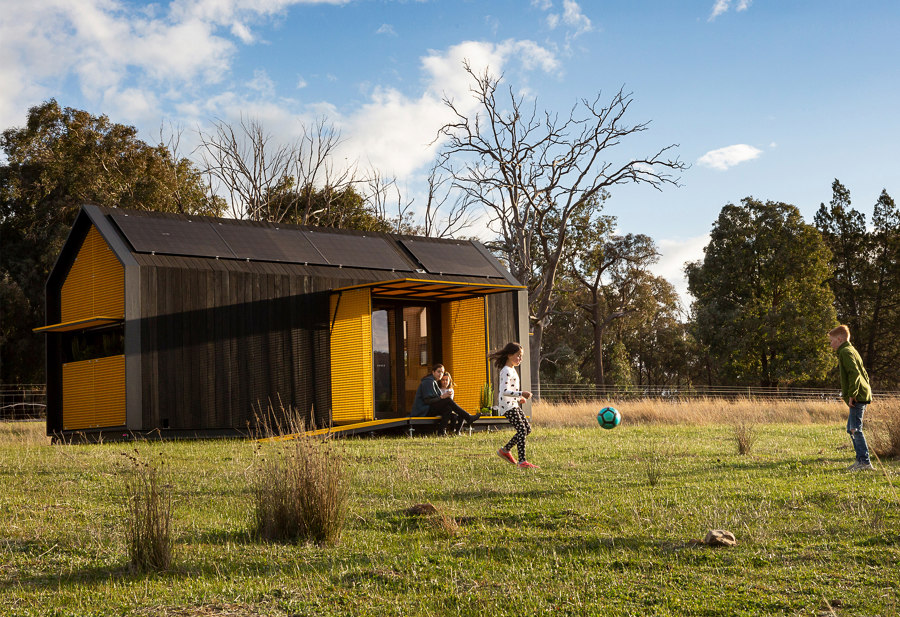Up close and personal: micro-living spaces
Scritto da Peter Smisek
19.06.19
Super-small architectural spaces for living are having a big impact on the way we think about need, comfort and sustainability. Move a bit closer.
OPod Tube House, Hongkong, James Law Cybertecture. Photo: James Law Cybertecture
While architects have always strived for efficiency when designing affordable housing, the current trend for micro living goes beyond the 20th-century idea of 'Existenzminimum'. By putting the emphasis on sustainability and tailoring micro dwellings to the user's requirements, as well as carefully integrating them in different contexts, architects around the world are making micro living an appealing lifestyle choice.
Micro living units are not just popping up across dense and highly desirable urban areas. Maddison Architects' Tiny Home is a compact, prefabricated cabin designed for the Australian suburbs and countryside. Featuring a simplified outline of a house, the slim black volume contains a compact bathroom and a single room that contains a small kitchenette, an in-built sofa-bed and a mezzanine reading area. A large floor-to-ceiling window along with a sheltered, folding verandah directs views to the outside to create a feeling of spaciousness inside the small space.
Like many rural micro houses, Tiny Home by Maddison Architects incorporates photovoltaic panels, highly insulated outer walls, and is designed to be able to be transported by a lorry and function off-grid. Photographer: Beechworth Photographers

Like many rural micro houses, Tiny Home by Maddison Architects incorporates photovoltaic panels, highly insulated outer walls, and is designed to be able to be transported by a lorry and function off-grid. Photographer: Beechworth Photographers
×In Buenos Aires, IR arquitectura has designed a micro living space – El Camarín – that fits within a missing street corner, which resulted from fragmented development in the 1950s. The trapezoidal floor plan is divided into a triangular living space screened off from a rectangular raised bed using open shelves. A kitchenette, integrated within a wall of built-in storage, completes the space, while a hidden door leads to the bathroom. A screened balcony, accessed through folding glass doors, allows for the inhabitants to expand their living space in the summer, while providing views of the outside and acting as a buffer for privacy.
Balancing the need for views and semi-outdoor spaces with privacy is essential to micro living in urban areas, as demonstrated by IR aquitectura's El Camarín, a compact corner studio. Photographer: Fernando Schapochnik

Balancing the need for views and semi-outdoor spaces with privacy is essential to micro living in urban areas, as demonstrated by IR aquitectura's El Camarín, a compact corner studio. Photographer: Fernando Schapochnik
×Existing spaces can also be adapted into micro living units, such as the 21-square-metre Garage/Studio in Vilnius, Lithuania. Adapted by IM Interior, the small structure has been re-clad in corten steel on the outside to preserve its industrial look, while the inside was finished in birch plywood. The kitchenette and a sofa bed with storage underneath are located at opposite ends of the space, leaving the middle of this micro home free and uncluttered. A small, wooded hill partially subsumes the building, creating a more comfortable distance between the entrance and the street.
IM Interior's Garage/Studio is a successful micro living conversion in which the architects have managed to create a robust, almost defensive exterior with a warm and welcoming internal space. Photographer: Leonas Garbačauskas

IM Interior's Garage/Studio is a successful micro living conversion in which the architects have managed to create a robust, almost defensive exterior with a warm and welcoming internal space. Photographer: Leonas Garbačauskas
×James Law Cybertecture took re-use a step further with their Opod Tube House prototype in Hong Kong. The micro living space is formed from a standard 2.5-metre concrete water pipe. Fitted with open shelves, a bench that turns into a bed, a microwave, a shower and – important in Hong Kong’s tropical climate – an air conditioning unit, this micro home is designed to provide a temporary shelter to people affected by Hong Kong's chronic housing shortage.
OPod Tube House by James Law Cybertecture can be moved easily and stacked on vacant land to create micro living communities. Photography: James Law Cybertecture

OPod Tube House by James Law Cybertecture can be moved easily and stacked on vacant land to create micro living communities. Photography: James Law Cybertecture
ש Architonic























